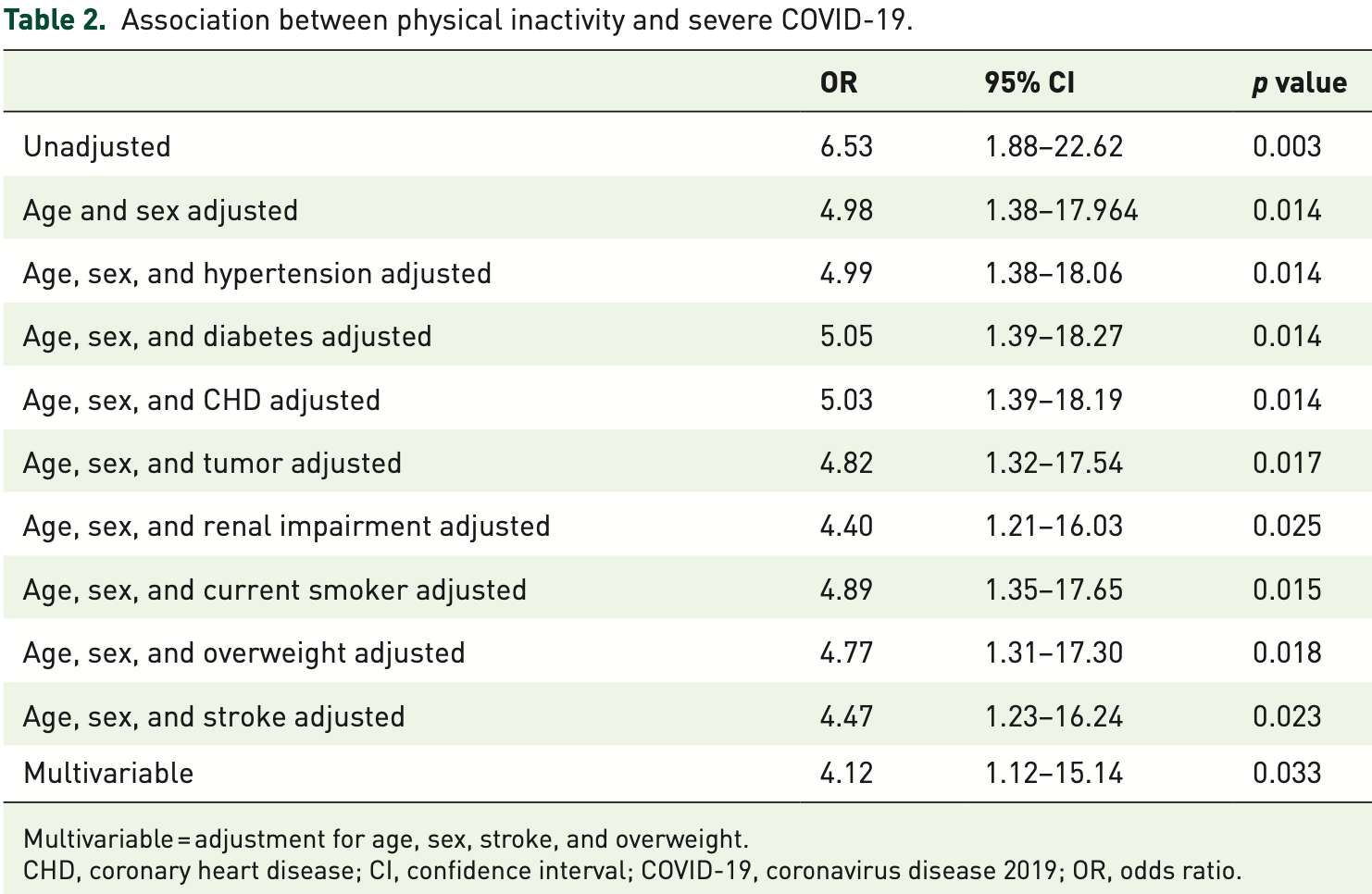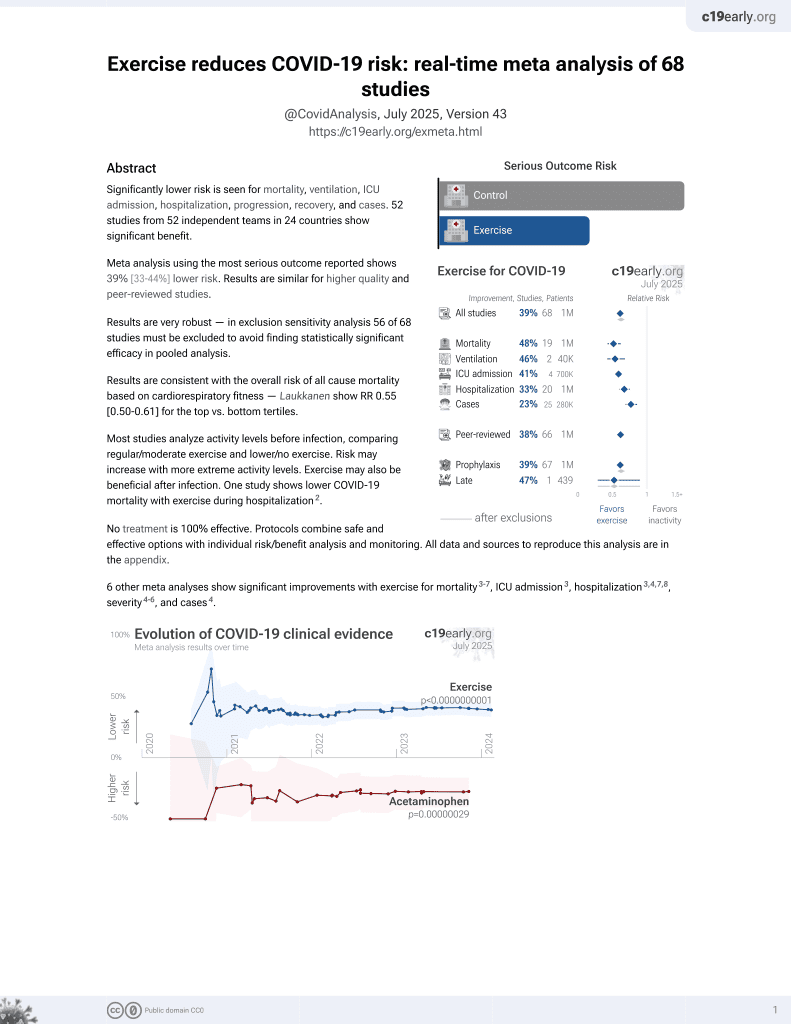
Does pre-existent physical inactivity have a role in the severity of COVID-19?
et al., Therapeutic Advances in Respiratory Disease, doi:10.1177/17534666211025221, Jun 2021
Exercise for COVID-19
9th treatment shown to reduce risk in
October 2020, now with p < 0.00000000001 from 68 studies.
No treatment is 100% effective. Protocols
combine treatments.
6,300+ studies for
210+ treatments. c19early.org
|
Retrospective 164 COVID-19 patients in China, showing physical inactivity associated with an increased risk of severe COVID-19.
Standard of Care (SOC) for COVID-19 in the study country,
China, is average with moderate efficacy for approved treatments1.
|
risk of death, 90.5% lower, RR 0.09, p = 0.09, high activity levels 0 of 61 (0.0%), low activity levels 6 of 103 (5.8%), NNT 17, relative risk is not 0 because of continuity correction due to zero events (with reciprocal of the contrasting arm), excluded in exclusion analyses:
excessive unadjusted differences between groups.
|
|
risk of severe case, 70.0% lower, RR 0.30, p = 0.03, high activity levels 3 of 61 (4.9%), low activity levels 26 of 103 (25.2%), NNT 4.9, adjusted per study, inverted to make RR<1 favor high activity levels, odds ratio converted to relative risk, multivariable.
|
| Effect extraction follows pre-specified rules prioritizing more serious outcomes. Submit updates |
Yuan et al., 20 Jun 2021, retrospective, China, peer-reviewed, 9 authors, study period 15 February, 2020 - 14 March, 2020.
Does pre-existent physical inactivity have a role in the severity of COVID-19?
Therapeutic Advances in Respiratory Disease, doi:10.1177/17534666211025221
Background and Aims: Physical inactivity is considered an important lifestyle factor for overweight and cardiovascular disease. We aimed to investigate the association between preexistent physical inactivity and the risk of severe coronavirus disease 2019 (COVID-19). Methods: We included 164 (61.8 ± 13.6 years) patients with COVID-19 who were admitted between 15 February and 14 March 2020 in this retrospective study. We evaluated the association between pre-existent physical inactivity and severe COVID-19 using a logistic regression model. Results: Of 164 eligible patients with COVID-19, 103 (62.8%) were reported to be physically inactive. Univariable logistic regression analysis showed that physical inactivity was associated with an increased risk of severe COVID-19 [unadjusted odds ratio (OR) 6.53, 95% confidence interval (CI) 1.88-22.62]. In the multivariable regression analysis, physical inactivity remained significantly associated with an increased risk of severe COVID-19 (adjusted OR 4.12, 95% CI 1.12-15.14) after adjustment for age, sex, stroke, and overweight. Conclusion: Our data showed that pre-existent physical inactivity was associated with an increased risk of experiencing severe COVID-19. Our findings indicate that people should be encouraged to keep physically active to be at a lower risk of experiencing a severe illness when COVID-19 infection seems unpredicted. The reviews of this paper are available via the supplemental material section.
Conflict of interest statement The authors declare that there is no conflict of interest.
Funding The authors disclosed receipt of the following financial support for the research, authorship, and/or publication of this article: This work was supported by the Fujian Natural Science Foundation (2018J01309) and the Fujian Provincial Natural and Science Innovation Project (No. 2016B014). On behalf of the Fujian Medical Team Support Wuhan for COVID-19.
ORCID iD Qilin Yuan https://orcid.org/0000-0001-8941-0863
Supplemental material The reviews of this paper are available via the supplemental material section.
References
Ahmed, COVID-19 -does exercise prescription and maximal oxygen uptake (VO 2 max) have a role in risk-stratifying patients?, Clin Med (Lond)
Burtscher, Millet, Burtscher, Low cardiorespiratory and mitochondrial fitness as risk factors in viral infections: implications for COVID-19, Br J Sports Med
Cai, Chen, Wang, Obesity and COVID-19 severity in a designated hospital in Shenzhen, China, Diabetes Care
Coleman, Ngor, Reynolds, Initial validation of an exercise "vital sign" in electronic medical records, Med Sci Sports Exerc
Da Silveira, Da, Fagundes, Bizuti, Physical exercise as a tool to help the immune system against COVID-19: an integrative review of the current literature, Clin Exp Med
Du, Chen, Pan, Prevalence and outcomes of re-positive nucleic acid tests in discharged COVID-19 patients, Eur J Clin Microbiol Infect Dis
Furtado, Letieri, Caldo-Silva, Sustaining efficient immune functions with regular physical exercise in the COVID-19 era and beyond, Eur J Clin Invest
Hamer, Kivimäki, Gale, Lifestyle risk factors, inflammatory mechanisms, and COVID-19 hospitalization: a community-based cohort study of 387,109 adults in UK, Brain Behav Immun
Huang, Wang, Li, Clinical features of patients infected with 2019 novel coronavirus in Wuhan, China, Lancet
Jesus, Vanhee, Deramaudt, Promising effects of exercise on the cardiovascular, metabolic and immune system during COVID-19 period, J Hum Hypertens
Laddu, Lavie, Phillips, Physical activity for immunity protection: inoculating populations with healthy living medicine in preparation for the next pandemic, Prog Cardiovasc Dis
Nieman, Wentz, The compelling link between physical activity and the body's defense system, J Sport Health Sci
Pietiläinen, Kaprio, Borg, Physical inactivity and obesity: a vicious circle, Obesity
Pranata, Huang, Lim, Impact of cerebrovascular and cardiovascular diseases on mortality and severity of COVID-19 -systematic review, meta-analysis, and meta-regression, J Stroke Cerebrovasc Dis
Sallis, Young, Tartof, Physical inactivity is associated with a higher risk for severe COVID-19 outcomes: a study in 48440 adult patients, Br J Sports Med. Epub ahead of print, doi:10.1136/bjsports-2021-104080
Song, Ren, Sun, Benefits of exercise on influenza or pneumonia in older adults: a systematic review, Int J Environ Res Public Health
Wang, Hu, Hu, Clinical characteristics of 138 hospitalized patients with 2019 novel coronavirus-infected pneumonia in Wuhan, China, JAMA
Wu, Chen, Cai, Risk factors associated with acute respiratory distress syndrome and death in patients with coronavirus disease 2019 pneumonia in Wuhan, China, JAMA Intern Med
Zhou, Yu, Du, Clinical course and risk factors for mortality of adult inpatients with COVID-19 in Wuhan, China: a retrospective cohort study, Lancet
DOI record:
{
"DOI": "10.1177/17534666211025221",
"ISSN": [
"1753-4666",
"1753-4666"
],
"URL": "http://dx.doi.org/10.1177/17534666211025221",
"abstract": "<jats:sec><jats:title>Background and Aims:</jats:title><jats:p> Physical inactivity is considered an important lifestyle factor for overweight and cardiovascular disease. We aimed to investigate the association between pre-existent physical inactivity and the risk of severe coronavirus disease 2019 (COVID-19). </jats:p></jats:sec><jats:sec><jats:title>Methods:</jats:title><jats:p> We included 164 (61.8 ± 13.6 years) patients with COVID-19 who were admitted between 15 February and 14 March 2020 in this retrospective study. We evaluated the association between pre-existent physical inactivity and severe COVID-19 using a logistic regression model. </jats:p></jats:sec><jats:sec><jats:title>Results:</jats:title><jats:p> Of 164 eligible patients with COVID-19, 103 (62.8%) were reported to be physically inactive. Univariable logistic regression analysis showed that physical inactivity was associated with an increased risk of severe COVID-19 [unadjusted odds ratio (OR) 6.53, 95% confidence interval (CI) 1.88–22.62]. In the multivariable regression analysis, physical inactivity remained significantly associated with an increased risk of severe COVID-19 (adjusted OR 4.12, 95% CI 1.12–15.14) after adjustment for age, sex, stroke, and overweight. </jats:p></jats:sec><jats:sec><jats:title>Conclusion:</jats:title><jats:p> Our data showed that pre-existent physical inactivity was associated with an increased risk of experiencing severe COVID-19. Our findings indicate that people should be encouraged to keep physically active to be at a lower risk of experiencing a severe illness when COVID-19 infection seems unpredicted. The reviews of this paper are available via the supplemental material section. </jats:p></jats:sec>",
"alternative-id": [
"10.1177/17534666211025221"
],
"author": [
{
"ORCID": "http://orcid.org/0000-0001-8941-0863",
"affiliation": [
{
"name": "Department of Neurology, Fujian Medical University Union Hospital, Fuzhou, China, and Institute of Clinical Neurology, Fujian Medical University, Fuzhou, China"
}
],
"authenticated-orcid": false,
"family": "Yuan",
"given": "Qilin",
"sequence": "first"
},
{
"affiliation": [
{
"name": "Department of Rehabilitation, Fujian Medical University Union Hospital, Fuzhou, China"
}
],
"family": "Huang",
"given": "Hua-yao",
"sequence": "additional"
},
{
"affiliation": [
{
"name": "Department of Infectious Disease, Fujian Medical University Union Hospital, Fuzhou, China"
}
],
"family": "Chen",
"given": "Xiao-ling",
"sequence": "additional"
},
{
"affiliation": [
{
"name": "Department of Neurology, Fujian Medical University Union Hospital, Fuzhou, China, and Institute of Clinical Neurology, Fujian Medical University, Fuzhou, China"
}
],
"family": "Chen",
"given": "Rong-hua",
"sequence": "additional"
},
{
"affiliation": [
{
"name": "Department of Rehabilitation, Fujian Medical University Union Hospital, Fuzhou, China"
}
],
"family": "Zhang",
"given": "Yixian",
"sequence": "additional"
},
{
"affiliation": [
{
"name": "Department of Critical Care Medicine, Fujian Provincial Hospital South Branch, Fuzhou, China"
}
],
"family": "Pan",
"given": "Xiao-bin",
"sequence": "additional"
},
{
"affiliation": [
{
"name": "Department of Critical Care Medicine, Fujian Provincial Hospital South Branch, Fuzhou, China"
}
],
"family": "Chen",
"given": "Jun-nian",
"sequence": "additional"
},
{
"affiliation": [
{
"name": "Department of Neurology, Fujian Medical University Union Hospital, Fuzhou, China, and"
},
{
"name": "Department of Rehabilitation, Fujian Medical University Union Hospital, Fuzhou, China"
}
],
"family": "Liu",
"given": "Nan",
"sequence": "additional"
},
{
"affiliation": [
{
"name": "Department of Neurology, Fujian Medical University Union Hospital, 29 Xinquan Road, Gulou District, Fuzhou 35000, China"
}
],
"family": "Du",
"given": "Houwei",
"sequence": "additional"
}
],
"container-title": [
"Therapeutic Advances in Respiratory Disease"
],
"content-domain": {
"crossmark-restriction": true,
"domain": [
"journals.sagepub.com"
]
},
"created": {
"date-parts": [
[
2021,
6,
21
]
],
"date-time": "2021-06-21T03:19:05Z",
"timestamp": 1624245545000
},
"deposited": {
"date-parts": [
[
2021,
8,
3
]
],
"date-time": "2021-08-03T05:33:50Z",
"timestamp": 1627968830000
},
"funder": [
{
"award": [
"2018J01309"
],
"name": "the Fujian Natural Science Foundation"
},
{
"award": [
"2016B014"
],
"name": "the Fujian Provincial Natural and Science Innovation Project"
}
],
"indexed": {
"date-parts": [
[
2022,
3,
30
]
],
"date-time": "2022-03-30T00:51:47Z",
"timestamp": 1648601507464
},
"is-referenced-by-count": 0,
"issn-type": [
{
"type": "print",
"value": "1753-4666"
},
{
"type": "electronic",
"value": "1753-4666"
}
],
"issued": {
"date-parts": [
[
2021,
1
]
]
},
"language": "en",
"license": [
{
"URL": "https://creativecommons.org/licenses/by-nc/4.0/",
"content-version": "unspecified",
"delay-in-days": 0,
"start": {
"date-parts": [
[
2021,
1,
1
]
],
"date-time": "2021-01-01T00:00:00Z",
"timestamp": 1609459200000
}
}
],
"link": [
{
"URL": "http://journals.sagepub.com/doi/pdf/10.1177/17534666211025221",
"content-type": "application/pdf",
"content-version": "vor",
"intended-application": "text-mining"
},
{
"URL": "http://journals.sagepub.com/doi/full-xml/10.1177/17534666211025221",
"content-type": "application/xml",
"content-version": "vor",
"intended-application": "text-mining"
},
{
"URL": "http://journals.sagepub.com/doi/pdf/10.1177/17534666211025221",
"content-type": "unspecified",
"content-version": "vor",
"intended-application": "similarity-checking"
}
],
"member": "179",
"original-title": [],
"page": "175346662110252",
"prefix": "10.1177",
"published": {
"date-parts": [
[
2021,
1
]
]
},
"published-online": {
"date-parts": [
[
2021,
6,
20
]
]
},
"published-print": {
"date-parts": [
[
2021,
1
]
]
},
"publisher": "SAGE Publications",
"reference": [
{
"DOI": "10.1016/S0140-6736(20)30566-3",
"doi-asserted-by": "publisher",
"key": "bibr1-17534666211025221"
},
{
"DOI": "10.1016/S0140-6736(20)30183-5",
"doi-asserted-by": "publisher",
"key": "bibr2-17534666211025221"
},
{
"DOI": "10.1001/jama.2020.1585",
"doi-asserted-by": "publisher",
"key": "bibr3-17534666211025221"
},
{
"DOI": "10.2337/dc20-0576",
"doi-asserted-by": "publisher",
"key": "bibr4-17534666211025221"
},
{
"DOI": "10.1016/j.jstrokecerebrovasdis.2020.104949",
"doi-asserted-by": "publisher",
"key": "bibr5-17534666211025221"
},
{
"DOI": "10.1016/j.jshs.2018.09.009",
"doi-asserted-by": "publisher",
"key": "bibr6-17534666211025221"
},
{
"DOI": "10.1007/s10238-020-00650-3",
"doi-asserted-by": "publisher",
"key": "bibr7-17534666211025221"
},
{
"DOI": "10.1136/bjsports-2020-103572",
"doi-asserted-by": "publisher",
"key": "bibr8-17534666211025221"
},
{
"DOI": "10.1016/j.pcad.2020.04.006",
"doi-asserted-by": "publisher",
"key": "bibr9-17534666211025221"
},
{
"DOI": "10.1038/oby.2007.72",
"doi-asserted-by": "publisher",
"key": "bibr10-17534666211025221"
},
{
"DOI": "10.1038/s41371-020-00416-0",
"doi-asserted-by": "publisher",
"key": "bibr11-17534666211025221"
},
{
"DOI": "10.1016/j.bbi.2020.05.059",
"doi-asserted-by": "publisher",
"key": "bibr12-17534666211025221"
},
{
"DOI": "10.1249/MSS.0b013e3182630ec1",
"doi-asserted-by": "publisher",
"key": "bibr13-17534666211025221"
},
{
"DOI": "10.1007/s10096-020-04024-1",
"doi-asserted-by": "publisher",
"key": "bibr14-17534666211025221"
},
{
"author": "World Health Organization",
"key": "bibr15-17534666211025221",
"volume-title": "Clinical management of severe acute respiratory infection when novel coronavirus (nCoV) infection is suspected: interim guidance",
"year": "2020"
},
{
"DOI": "10.1001/jamainternmed.2020.0994",
"doi-asserted-by": "publisher",
"key": "bibr16-17534666211025221"
},
{
"DOI": "10.1136/bjsports-2021-104080.",
"doi-asserted-by": "publisher",
"key": "bibr17-17534666211025221"
},
{
"author": "Song Y",
"journal-title": "Int J Environ Res Public Health",
"key": "bibr18-17534666211025221",
"volume": "17",
"year": "2020"
},
{
"DOI": "10.1111/eci.13485",
"doi-asserted-by": "publisher",
"key": "bibr19-17534666211025221"
},
{
"DOI": "10.7861/clinmed.2020-0111",
"doi-asserted-by": "publisher",
"key": "bibr20-17534666211025221"
}
],
"reference-count": 20,
"references-count": 20,
"relation": {},
"resource": {
"primary": {
"URL": "http://journals.sagepub.com/doi/10.1177/17534666211025221"
}
},
"score": 1,
"short-container-title": [
"Ther Adv Respir Dis"
],
"short-title": [],
"source": "Crossref",
"subject": [
"Pharmacology (medical)",
"Pulmonary and Respiratory Medicine"
],
"subtitle": [],
"title": [
"Does pre-existent physical inactivity have a role in the severity of COVID-19?"
],
"type": "journal-article",
"update-policy": "http://dx.doi.org/10.1177/sage-journals-update-policy",
"volume": "15"
}
